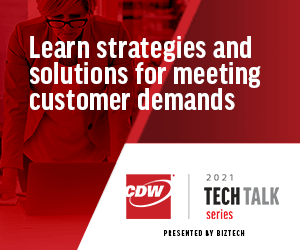Despite the pandemic — and in some ways because of it — 2020 turned out to be the year of digital transformation for many organizations.
Bill Polisson, vice president of enterprise data services at CDW, identified three trends that have become apparent as businesses have modernized over the past 13 months.
Polisson spoke as part of a recent CDW Tech Talk and said the first trend he noticed was the rapid rate of change at which organizations have adopted new IT policies and strategies. He said projects that have been planned out over the course of months or years were sped up to be completed in much less time — sometimes in a matter of weeks.
The second trend Polisson pointed out was “a continued migration of platforms and services up into the cloud. I think there’s been a lot more cloud adoption,” he said.
Last, he noted that more focus has been placed on the “omnichannel retailing experience.” Organizations have been developing strategies to touch their customers through their traditional processes, such as contact centers and direct communication with sales teams. However, they’ve also been taking advantage of rapid digital commerce touchpoints and blending these modern tools with traditional processes to provide a 360-degree customer view.
WATCH THE WEBCAST: Unlock the exclusive Insider video to learn more about the intersection of technology and social responsibility.
With Modernization Comes Increased Risk
While businesses have been able to realize the benefits of rapid change, this also has created some unwanted results. The security risk to sensitive data has increased, and bad actors are ready and waiting for any sign of vulnerability.
Ruben Chacon, vice president for technology and CISO at CDW, agreed with Polisson’s assessment but warned of potential pitfalls as well.
“When I hear ‘digital transformation’ and I see these types of events happening — like COVID-19 — I see gaps and I see digital dependencies. I see exciting opportunities, but also the need for increased security so we can prevent disruption,” Chacon said.
Polisson agreed and said it’s essential to remain focused on business outcomes when pursuing a modernization effort. He also emphasized the importance of focusing on the people and processes involved, because they will help to enable the intended business outcomes. In addition, he claimed that automation is necessary for digital transformation. “You want to really try to automate as many things as possible,” he said.
Regarding automation, he talked about the need for clean, solid data, which he called “the lifeblood of an organization.” Automation, including artificial intelligence and machine learning, are only possible when using complete, accurate and reliable data.
Basic Security Considerations During Modernization
Chacon offered a series of key security elements to keep in mind when pursuing modernization efforts.
He agreed with Polisson’s earlier point and said that the first step is to “understand your business and what you’re trying to support.” He also pointed out the need for security and technology professionals to speak the business’s language. Otherwise, they risk losing a connection with business leaders and outcomes.
From a security perspective, Chacon said it’s essential to ensure the readiness of offsite backups. He suggested adding increased training and awareness and increased security and privacy to the product lifecycle. He also recommended the implementation of a zero-trust model, but said, “Don’t go crazy. Implement it only when it makes sense.”
“Zero trust is more than an approach and a model. This can be operationalized” to protect networks, devices and data, he said.
Register below for an upcoming CDW Tech Talk, held Tuesdays at 1 p.m., to hear from IT experts live.
The Traditional Model of Security is Evolving
Matt Soseman, senior security architect for Microsoft Software, joined the discussion to talk about the ways that security has continued to change, especially in recognition of a mostly remote workforce.
The way we work has changed, Soseman said. “We’re at home. We’re anywhere except the office. We’re using devices that might be owned by the company, but might not be. They may be personal devices. We’re maybe not on a VPN. We’re probably not hard-wired into the company’s network. So, the model’s changed drastically.”
All of these changes are forcing IT leaders to rethink their approach to cybersecurity, Soseman said, “because our assets are really everywhere now.”
Soseman echoed Chacon in recommending a zero-trust model to handle evolving security needs. “The reality is that you’re using personal devices that probably aren’t managed. You’re using SaaS applications that IT has no idea you’re using. Your data is stored everywhere. The one common denominator to all of that is identity.”
A zero-trust model leverages identity and allows an organization to limit risk by identifying users and devices and controlling access to data based on that information. At Microsoft, the company has developed Azure Active Directory to harness the power of identity in the use of such tools as multifactor authentication and conditional access.
When considering a zero-trust model, it’s important to bring legal, HR, and senior leaders from every business unit into the conversation. It will require some translation from technical to business language, but Soseman said it can lead to “game-changing” business outcomes.
How Strategic Partnerships Can Assist with Business Outcomes
Corey Carrico, senior field marketing manager at CDW, also joined the conversation to talk about the advantages of a strategic partnership when an organization is looking to modernize.
CDW worked with a large, multifaceted, international retailer to help accomplish business outcomes that could’ve been derailed by the pandemic. The retailer was working to develop an infrastructure that would support initiatives such as shopper apps, loyalty programs, digital signage, data center cloud connectivity and security. When the pandemic hit, it required the company to reprioritize and dramatically accelerate the rate of implementation for those initiatives.
The retailer’s partnership with CDW allowed it to realize the business outcomes it had in mind, providing a better customer experience even during a time of increased restrictions and social distancing requirements.
Follow BizTech’s full coverage of the CDW Tech Talk series here. Insiders can register for the event series here.











